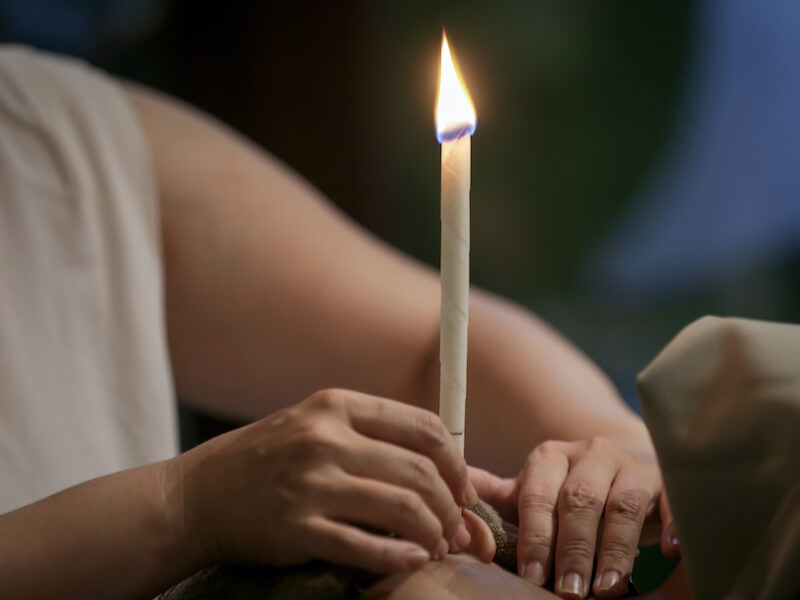
Everyone loves an easy fix, particularly when the fix is also a DIY fix. Sink Leaking? You can learn about how to fix that from a YouTube video. It may take you a little bit longer than it would take a plumber, but there’s no substitute for the gratification you feel, right?
But that feeling only lasts until your sink begins to leak again. Because, as it turns out, in some cases a DIY fix is no substitute for the well-sharpened skills of a professional.
It isn’t always easy to admit that this is the situation. And, in part, that’s why people will often continue to look for “easy” DIY-fixes for complex problems, which might help explain the popularity of something called ear candling (or, in some cases, earwax candling). It sounds… kind of gross, right? So, just what is ear candling, and how is it probably not the best thing ever? Well, let’s dig into that.
What is ear candling?
Everyone has had the feeling of a plugged ear now and then. On occasion, your ear will fill with mucus when you’re sick. In other situations, it might occur because you have too much earwax in your ears (and too much earwax can have a variety of causes). When this happens, you may experience a certain amount of discomfort. You may even experience a temporary loss in your ability to hear. It kind of stinks!
Some people, as a result, think that ear candling is just the inexpensive and novel fix they need. The idea is that a special hollow candle is placed into your ear (non-burning end). Somehow, the mix of heat and the hollow style of the candle changes the air pressure within your ear canal, drawing the earwax or mucus out.
It should be immediately noted that ear candling is not encouraged by healthcare professionals. Do ear candles actually pull wax out? No. There’s absolutely no proof that ear candling is effective (especially not in the way that it’s supposed to work). Essentially, most hearing and healthcare professionals will emphatically advocate against ever utilizing this approach. (Does ear candling help with sinus pressure? Also no.)
Just listen to the FDA! (What is the FDA advising about ear candling? In essence, don’t do it!)
The negative aspects of ear candling
Ear candling might feel safe, initially. It’s just a tiny flame. And the “equipment” is specialized. And people on the internet claimed it was safe! So how could it be possible for ear candling to be harmful?
Unfortunately, there’s no mistaking the fact that ear candling can be downright hazardous. What are the negative effects of ear candling? Here are just a few of the (possibly painful) ways that ear candling can affect your health:
- Your face could be severely burned: There’s always a pretty good possibility that if you’re holding a flame up near your ear, you might burn your face. Accidents will happen! It’s all too easy for candle wax to drip into your eyes or for your hair to catch on fire or for your face to get seriously burned.
- The earwax can be crammed even further into your ear: Putting an ear candle inside your ear can actually push earwax further into the ear canal much like when you utilize a cotton swab. In other words, ear candling can make your earwax issue worse! Other complications, from hearing loss to ear infections can also be the outcome.
- Your Eardrum could accidentally get punctured: Whenever you insert something into your ear, you put yourself at risk! You might accidentally pierce your eardrum, creating significant discomfort and harm to your hearing. If this occurs it’s very likely that you will need to get professional assistance.
- You can cause severe burns to your ear: Fire is hot, melting wax is too. If the tip of the candle or the wax goes into where it’s not supposed to, you’re looking at some considerable burning possibilities in your ear (and your ear is a sensitive spot).
- You can leave candle wax behind in your ear: The candle wax can get into your ears even if you don’t get burned. Your hearing can become impacted from this, not to mention the uncomfortableness.
So, is ear candling endorsed by hearing healthcare professionals? No… not even a little bit! Not only is ear candling not helpful, it’s actually very dangerous!
So how should you get rid of earwax?
Earwax is actually a good thing. In normal amounts, it’s beneficial for your ears. Issues start when there’s too much earwax or when it won’t drain effectively. So what should you do if using a candle is a bad idea?
If you have an earwax obstruction, the best thing to do might be speaking with a hearing specialist. They might advise some at-home alternatives (such as using saline or mineral oil to soften the wax, allowing it to sort of slide out on its own). But in some cases, they will perform a cleaning for you.
We can remove the wax safely with specialized tools and training.
It’s best to steer clear of things like ear candles and cotton swabs. Unless your hearing specialist says differently, it’s a good policy to never put anything smaller than your finger in your ear.
How to help your ears feel better
If excess earwax is causing you a little discomfort or misery, you should make an appointment with us. We will be able to help you clean any stubborn earwax out of your ears and get you back to feeling normal.
References
https://www.fda.gov/consumers/health-fraud-scams/ear-candling-ineffective-and-risky